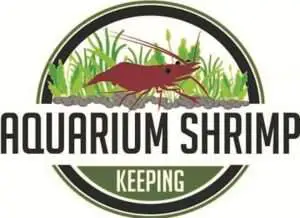Hello there! As an ardent shrimp keeper, I’ve spent countless hours observing the behavior of these fascinating little creatures in my various aquariums over the years. One of the questions that kept popping up in my early days, and I suspect might be plaguing you now, is “How to sex shrimp?”
Indeed, it’s a skill that, while a bit tricky to master, is essential if you plan on breeding your shrimp or just simply curious about the mix of your tiny aquatic community.
My first successful shrimp sexing attempt occurred about five years ago. I remember squinting into the tank, flashlight in one hand and a magnifying glass in the other, straining to spot those telltale signs of the shrimp’s gender.
But with practice, patience, and a keen eye, I’ve improved significantly. I’m here to share this knowledge and guide you through this process.
Determining the gender of shrimp involves observing certain physical characteristics, and while it might sound like detective work, it can be quite a fun and educational journey, especially if you’re as shrimp-smitten as I am.
With a little patience and a good dose of curiosity, you’ll soon be sorting your Caridina from your Neocaridina, males from females, faster than a shrimp can flick its tail! Alright, that might be a small exaggeration (those little fellas can zip around pretty quick), but you get the gist. It’s time to turn you into a shrimp-sexing superstar!
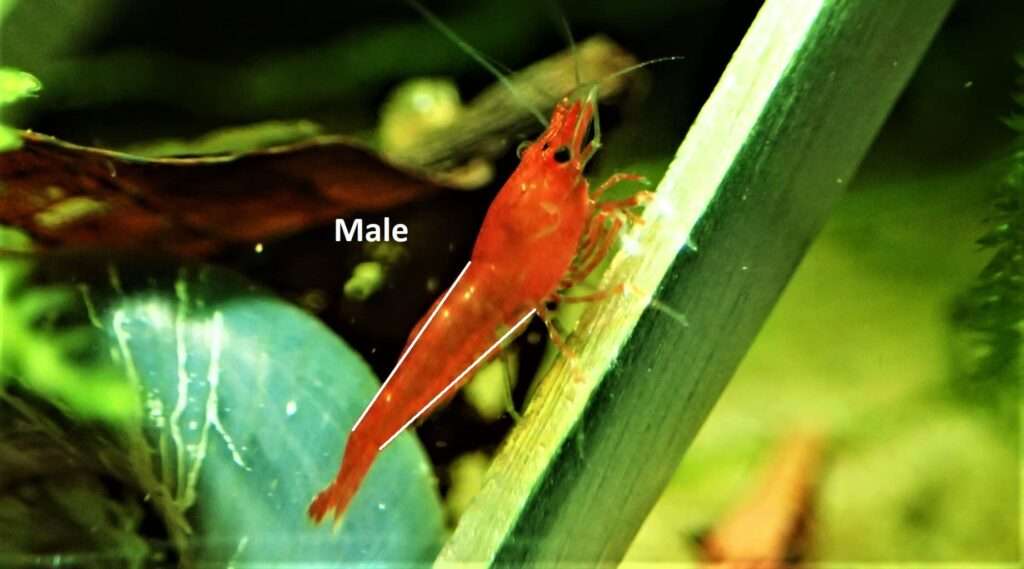
Description of Male Shrimp
Let’s start off with the males. The male cherry shrimp tend to have a leaner look – think of them as the marathon runners of the shrimp world. Their bodies are built for efficiency and speed, with a noticeably flat belly that tucks neatly in.
This streamlined body shape allows them to move quickly and effortlessly through the water(I call this super manning), easily navigating their surroundings. Males are generally smaller than their female counterparts, and their slender bodies are a key feature to help identify them.
It’s a fascinating testament to nature’s design, where every feature has a purpose and contributes to the shrimp’s overall survival and lifestyle.
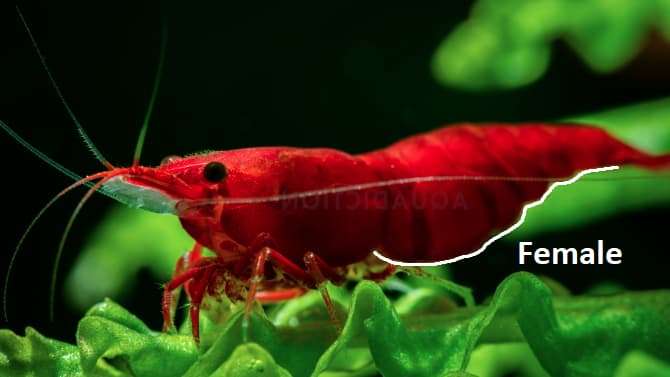
Description of Female Shrimp
Now, let’s move on to the females. Female cherry shrimp are the curvy ones of the species. They have a distinct, round belly, which is one of their most identifiable features. This roundness isn’t just about looks; it’s actually because they are built to carry eggs.
Unlike streamlined males, females have a fuller, more robust shape. Their bodies are designed to nurture and protect their eggs until they are ready to hatch. This protective design is what gives them their distinctive round bellies and makes them slightly larger and fuller than the males.
It’s a wonderful example of how nature has equipped each gender with the features needed for their roles in reproduction.
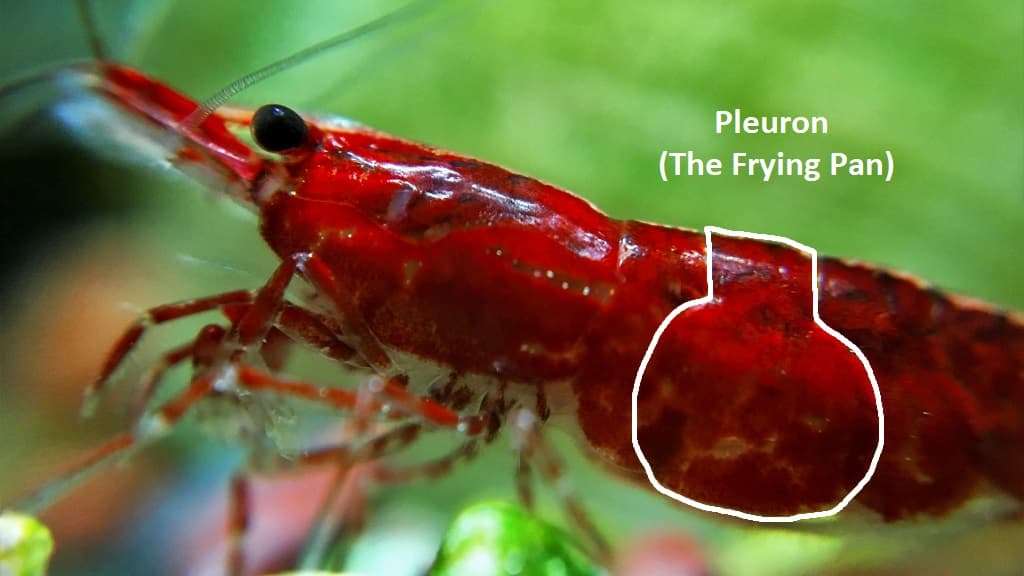
How to Sex Shrimp The Pleuron (The Frying Pan)
Now, let’s dive a bit deeper into the anatomy of a shrimp. In particular, let’s talk about a part called the Pleuron. This second plate of the belly is a key characteristic that differentiates males from females.
In males, this plate is more streamlined and tucks neatly under the first, maintaining the overall sleek shape of their bodies. In females, however, it overlaps the first and third plates, giving it a rounder shape. Think of it as a bit like a frying pan in shape. It’s a unique feature that’s very helpful in distinguishing the gender of your cherry shrimp.
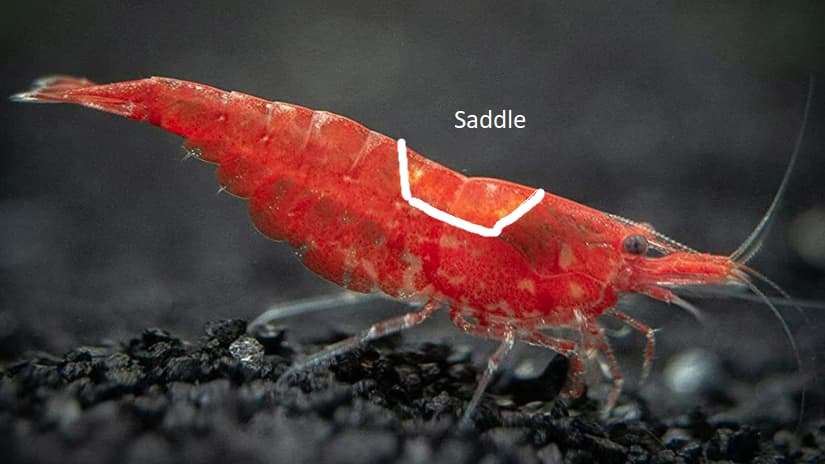
The Saddle in Female Shrimp
Now, let’s talk about an intriguing feature found in female shrimp – the ‘saddle’. You might be curious why it’s called that, right? Well, its location and shape resemble a horse’s saddle.
The saddle is a specialized area located near the neck, in the upper part of the shrimp’s body. It serves as a storage site for the ovaries, where the eggs develop before they are ready to be fertilized.
When the female shrimp is prepared to reproduce, the eggs move from the ovaries within the saddle to the underside of her body, where they will be fertilized and carefully carried until they hatch. It’s an incredible process, and the saddle plays a critical role in it.
This is an important time for pre-egg development, as we want the tiny unborn shrimp growing within these eggs to have the best possible start. To ensure this, it’s crucial to provide the female shrimp with a nutrient-dense diet. A well-balanced and nutritious diet will contribute to the quality of the eggs within the ovaries, providing them with the essential resources needed for healthy development.
By paying attention to their nutrition, we can help support the growth and well-being of the next generation of shrimp in our aquariums.
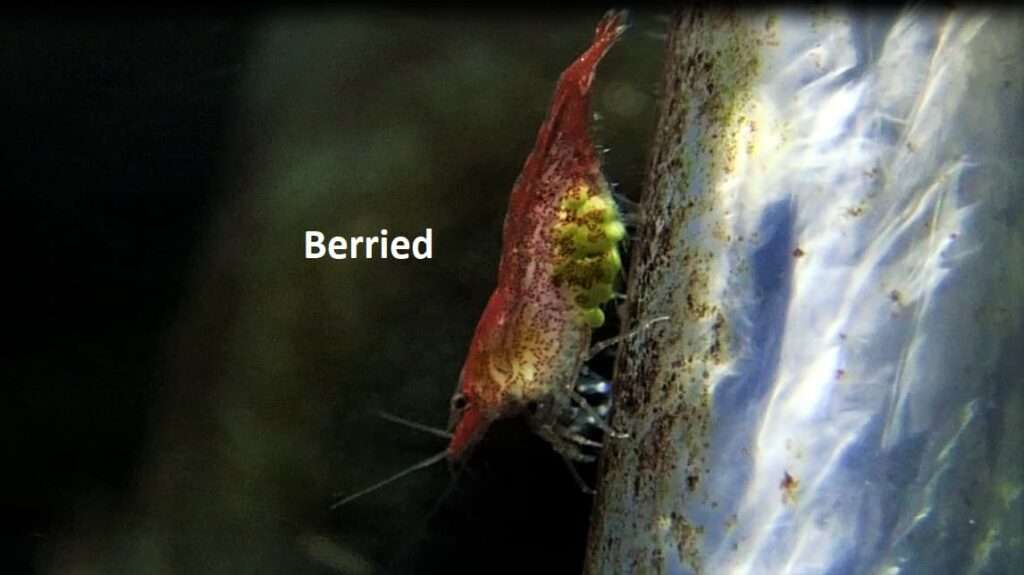
The Eggs in Female Shrimp (Berried)
Speaking of eggs, One of the easiest ways to tell if a cherry shrimp is female is by checking for eggs. Female shrimp proudly carry their eggs on the underside of their bodies, and this exciting stage is referred to as being “berried” due to the resemblance of the egg cluster to a small berry.
The gestation period for cherry shrimp typically lasts around 3-4 weeks, during which the eggs develop and mature. Temperature plays a crucial role in this process, as slightly warmer water can influence the hatching time.
For successful Neocaridina breeding, maintaining a temperature of approximately 24°C (75°F) is considered optimal. This slight increase in temperature can accelerate the hatching process, leading to faster egg development and the emergence of tiny shrimp offspring.
When the eggs finally hatch, it’s truly a magical sight. The newborn shrimp, known as shrimplets, resemble miniature versions of their adult. Measuring around 2mm (0.08 inches) in size, these tiny replicas are incredibly delicate but remarkably well-formed. It’s amazing to witness the rapid growth and development of these tiny creatures from their humble beginnings.
Creating an optimal environment for successful shrimp breeding is crucial. By maintaining stable water parameters, including temperature and water quality, you provide the best conditions for egg development and hatching. Additionally, offering a varied and nutritious diet contributes to the overall health and growth of both the berried female and the newly hatched fry.
So, keep an eye out for berried females in your shrimp tank, as they signify the possibility of new life and the continuation of the shrimp population.
Sexing Different Types of Shrimp
Here’s the best part these identification tips aren’t just for cherry shrimp. They work for other types of dwarf shrimp too, like crystals and Sulawesi.
Different shrimp species may have different colorations or sizes, but these basic physical characteristics – the streamlined males, the rounder females, the pleuron, the saddle, and the egg-carrying females – can be used as a guide across the board.
This means that, with a little bit of practice, you’re now equipped to determine the gender of various shrimp species. So, whether you’re just starting your shrimp-keeping journey or looking to expand your existing collection, you now have a handy skill at your disposal.

Mating After Molting
Shrimp mating is an intriguing process that often takes place after a female shrimp undergoes molting. Molting is the shedding of the old exoskeleton to allow for growth. Typically, female shrimp molt approximately every 4-5 weeks, although this can vary depending on individual shrimp and environmental conditions.
After molting, female shrimp become more receptive to mating. This is because the female’s new exoskeleton is softer and more flexible, making it easier for the male shrimp to transfer his sperm to fertilize the eggs. Male shrimp are often quick to detect this opportunity and will actively seek out molting females for mating.
Observing the molting patterns of your shrimp can help you anticipate when mating is more likely to occur. Providing a comfortable and secure environment with appropriate hiding spots and a balanced male-to-female ratio will increase the chances of successful mating and breeding in your shrimp tank.
Important Terms You Should Remember
To better understand the world of cherry shrimp, let’s familiarize ourselves with some key terms again.
1. Saddle: When we talk about the “saddle” in female shrimp, we’re referring to a specialized area near the neck where the eggs are stored before they’re ready to be fertilized. The name “saddle” comes from its location and shape, reminiscent of a horse’s saddle.
2. Berried: When a female shrimp is carrying eggs, it’s commonly referred to as being “berried.” This term describes the visual appearance of the egg cluster, resembling a small berry. It’s an exciting stage that signals the potential for new life in your shrimp tank.
3. The Pleuron: The pleuron is a scientific term referring to a specific part of a shrimp’s body. It is a plate-like structure located on the side of the shrimp’s abdomen or belly. In males, the pleuron is streamlined and neatly tucks under the first plate, maintaining their slender body shape.
In females, the pleuron overlaps the first and third plates, resulting in a rounder shape. While “frying pan” is not the scientific term for the pleuron, it can be a helpful and imaginative way to visualize its appearance.
Conclusion
When it comes to the intriguing task of shrimp sexing, remember that patience, close observation, and practice are your best friends. It might seem challenging at first, but over time, you’ll start noticing the subtle differences, like the curve of the abdomen or the size of the shrimp.
Understanding your shrimp’s gender can offer you insight into their behavior, improve your breeding strategies, and enrich your overall shrimp keeping experience.
If you ever find yourself stuck or needing a second opinion on your shrimp’s gender, please don’t hesitate to reach out. There’s no such thing as a silly question in the world of shrimp keeping, we’ve all been there! Remember, every expert was once a beginner, and I’m here to help you navigate through your shrimp-filled journey.
Happy Shrimp Keeping!
Frequently Asked Questions about Sexing Cherry Shrimp
Q. How can you tell if a shrimp is a female or male? A. Female shrimp are typically larger with a rounder abdomen, especially when carrying eggs. Males are smaller and have a more streamlined abdomen. The differences can be subtle, so practice makes perfect!
Q. How to sex blue dream shrimp? A. Like many shrimp species, blue dream shrimp females are larger, with a more rounded underbelly. Males are slimmer. Female blue dreams also have a characteristic saddle shape near their head, where eggs mature before being transferred to the belly.
Q. Can you sex cherry shrimp? A. Yes, cherry shrimp can be sexed using the same methods. Female cherry shrimp are larger, rounder, and often have a more vibrant color. Males are smaller, leaner, and less vividly colored.
Q. How do you sex ghost shrimp? A. Ghost shrimp are trickier due to their transparent bodies. However, females will show a visible saddle or an egg-filled underbelly. Males are generally smaller and more slender.
Q. Do all shrimp turn female? A. No, not all shrimp species change sex. While some marine species display sequential hermaphroditism, freshwater shrimp used in aquaria, like cherry or ghost shrimp, do not switch sex.
Q. Are all shrimps female? A. No, shrimp populations have both males and females. The ability to discern the gender of your shrimp enables better understanding of their behaviors and breeding.
Q. At what age can you sex cherry shrimp? A. Cherry shrimp can typically be sexed when they reach maturity, around 2 to 3 months old. However, it might still be challenging due to their small size and slight sexual dimorphism
